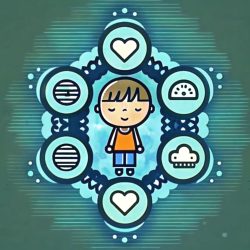Question More, Action Knowledge.
Remember, at QMAK, we don’t just teach; we empower. We don’t just inform; we inspire. We don’t just question; we act. Become a Gold Member, and let’s unlock your child’s full potential, one question at a time.
Back to Mind Explorers
![]()
This game helps children develop a deeper understanding of what it means to be present and aware without striving or struggling. By exploring the effortless nature of many aspects of their experience, children learn to appreciate the natural flow of awareness and to trust in the inherent wisdom of their own being.
At the same time, by practicing the delicate balance of putting in just enough effort to stay focused on awareness itself, children cultivate the skill of mindfulness and learn to navigate the constantly changing landscape of their inner world with greater ease and clarity.
This exercise can also help children understand the difference between true effortlessness, which arises from a place of deep presence and acceptance, and mere laziness or disengagement, which can lead to a sense of disconnection and dissatisfaction.
Overall, “The Effortless Awareness Explorer” game can help children develop a more grounded, centered, and accepting relationship with their own experience, as they learn to rest in the natural effortlessness of pure awareness while still engaging with the world around them with curiosity, care, and a light touch.
Hey there, young mindfulness adventurer!
Today, we're going to play a game called "The Effortless Awareness Explorer."
This game will help us understand what it means to be present and aware without putting in too much effort.
We'll be exploring the things that happen naturally and effortlessly in our experience, like seeing, hearing, and feeling.
At the same time, we'll practice using just the right amount of effort to stay focused on our awareness itself, rather than getting lost in our thoughts or daydreams.
Are you ready to discover the magic of effortless awareness?
1. Explain to the child that being present and aware doesn’t require a lot of effort. Encourage them to find the least amount of effort needed to stay focused on awareness itself, rather than the contents of awareness (thoughts, emotions, sensations).
2. Help the child understand that putting in too much effort can make it harder to be aware, while putting in no effort at all can lead to getting lost in daydreams or thoughts about the past or future.

3. Ask the child to focus on the things that happen effortlessly in their experience, such as hearing, seeing, feeling, and thinking. Encourage them to let these experiences happen naturally without trying to control them.
4. Guide the child to ask themselves, “What is effortless in my experience right now?” Have them consider whether hearing, seeing, feeling, thinking, and awareness itself are effortless.

5. Explain the difference between effortlessness and zero effort. Zero effort activities, like watching TV or letting the mind wander, are different from effortlessness, which requires a small amount of effort to stay focused on pure awareness.
6. Encourage the child to practice finding the balance between putting in just enough effort to stay aware of awareness itself and allowing everything else to be as it is.

To further explore the concept of effortless awareness and the balance between effort and letting go, consider introducing your child to the book “Alphabreaths: The ABCs of Mindful Breathing” by Christopher Willard.
Synopsis: Uses creative breathing techniques (e.g., “Butterfly Breath”) to teach children how mindfulness can feel as natural as the alphabet.
Connection: Makes effortless awareness accessible through playful, intuitive practices.
Verse 1:
Open your eyes, what do you see?
Colors and shapes flow naturally
Listen close, what do you hear?
Sounds all around, crisp and clear
Pre-Chorus:
No need to push, no need to try
Just let it all flow gently by
Chorus:
Just be, just be
Awareness comes so easily
Not too much, not too little
Find the balance in the middle
Verse 2:
Feel the breeze upon your skin
Thoughts arise from deep within
It’s all happening on its own
A dance of life that you’ve always known
(Pre-Chorus)
(Chorus)
Bridge:
Stay awake, but don’t you strain
Let go and feel the joy again
You’re the watcher of it all
Present in the big and small
(Chorus)
Outro:
So when life gets tough and busy
Remember how to take it easy
Just be present, just aware
The magic’s always waiting there
Remember, at QMAK, we don’t just teach; we empower. We don’t just inform; we inspire. We don’t just question; we act. Become a Gold Member, and let’s unlock your child’s full potential, one question at a time.